
Leveraging Predictive Analytics for a Competitive Advantage
Predictive analytics has emerged as a game-changer for businesses, offering the ability to anticipate trends, understand customer behavior, and make informed decisions. By analyzing historical data and applying advanced algorithms, predictive analytics empowers organizations to stay ahead of the curve in an increasingly data-driven world.
Predictive analytics has emerged as a game-changer for businesses, offering the ability to anticipate trends, understand customer behavior, and make informed decisions. By analyzing historical data and applying advanced algorithms, predictive analytics empowers organizations to stay ahead of the curve in an increasingly data-driven world.
What is Predictive Analytics?
Predictive analytics uses historical data, statistical algorithms, and machine learning techniques to forecast future outcomes. It identifies patterns in past data and applies them to predict future trends. Unlike descriptive analytics, which looks at past performance, predictive analytics focuses on “what’s likely to happen next.”
Retailers leverage predictive analytics to analyze customer preferences, enabling personalized product recommendations and targeted promotions. Additionally, predictive models help optimize inventory by forecasting demand for specific products, reducing overstock and shortages. Healthcare Industries use predictive analytics to improve patient care. It aids in disease prevention by identifying high-risk patients early. Hospitals use it to predict patient readmission rates and plan resource allocation more effectively. The financial Industries can see substantial benefits from predictive analytics in the detection of fraud activities and allocate risk management resources in real time. They also assess credit risk, enabling better loan decisions and minimizing defaults. Manufacturers use predictive analytics to monitor equipment performance and predict maintenance needs. This approach minimizes downtime, reduces costs, and improves overall operational efficiency. Sports teams analyze player data to develop game strategies, assess performance, and prevent injuries. Predictive analytics played a key role in the “Moneyball” approach to building successful sports teams.
How Predictive Analytics Works
Gathering historical data from diverse sources is usually the first step in the process. Sources may include, but not limited to, CRM systems, sensors, and third-party providers. Cleaning and preprocessing data to ensure accuracy and consistency is an important process and should not be overlooked. Also, the use of algorithms like regression analysis, decision trees, or neural networks may be used to build predictive models. Applying the model to new data to generate forecasts and insights while monitoring model performance for consistent improvement is necessary to maintain accuracy.
Tools and Technologies for Predictive Analytics
- Open-Source Tools: Python (Scikit-learn, TensorFlow), R, Apache Spark.
- Commercial Platforms: SAS, IBM Watson, and Oracle Analytics.
- Cloud Solutions: AWS SageMaker, Google Cloud AI, and Microsoft Azure AI.
Benefits of Implementing Predictive Analytics
Predictive analytics empowers organizations to move beyond reactive decision-making by accurately forecasting future trends. By analyzing historical data, patterns, and emerging signals, businesses can anticipate customer behaviors, market shifts, and operational needs with greater precision. This foresight allows for proactive planning—whether it’s adjusting inventory levels, preparing marketing campaigns, or aligning staffing resources—leading to a more resilient and agile organization.
Rather than relying solely on intuition or past experiences, predictive analytics equips decision-makers with objective, data-backed insights. Advanced models highlight probable outcomes and assess the risks and benefits of various strategic options. This reduces guesswork, strengthens strategic planning, and improves the quality of decisions across departments like marketing, operations, finance, and HR. Organizations that embed predictive analytics into their decision-making processes are better positioned to achieve consistent, measurable results.
Through predictive models, businesses can identify inefficiencies before they escalate into costly problems. For example, by forecasting demand fluctuations, companies can streamline inventory management, minimize overproduction, and optimize supply chains. In service operations, predictive analytics help allocate labor more effectively, avoiding both understaffing and overstaffing. Overall, this leads to smarter resource allocation, reduced operational costs, and significant financial savings without sacrificing service quality.
Organizations that leverage predictive analytics gain a crucial advantage in today’s competitive markets. By spotting emerging opportunities such as untapped customer segments, trending products, or new geographic markets, businesses can act faster than their competitors. Additionally, predictive tools can uncover potential risks, such as churn signals from key customers or supply chain disruptions, allowing businesses to mitigate issues before they become critical. This ability to anticipate and act decisively strengthens market positioning and drives sustained success.
Getting Started with Predictive Analytics
Identify specific business problems you want to address with predictive analytics. Ensure your organization has the tools, technology, and talent to build and maintain predictive models. Begin with a pilot project to demonstrate value before expanding to larger initiatives. Partner with data analytics providers to accelerate your implementation.
Predictive analytics is not just a buzzword it’s a vital tool for businesses looking to thrive in a competitive landscape. By leveraging the power of predictive analytics, organizations can anticipate challenges, uncover opportunities, and make smarter decisions.